![Finished pintuck sets Pintucks - the Old Fashioned Way [tutorial] | HistoricalSewing.com](https://historicalsewing.com/wp-content/uploads/Finished-pintuck-sets.jpg)
Pintucks! So gloriously tiny! So delicate! So straight & even… or not.
Pintucks have a charm about them. They call to us because they signify something regal or heavenly. They appear aloof and untouchable. The beauty they add to Victorian petticoats and Edwardian chemises elevate such tantalizing garments.
So as dressmakers from another time, how do we accomplish this same level of extraordinaire with our own undergarments and shirtwaists? …without using the cheater method of a machine pintuck foot & double needle?
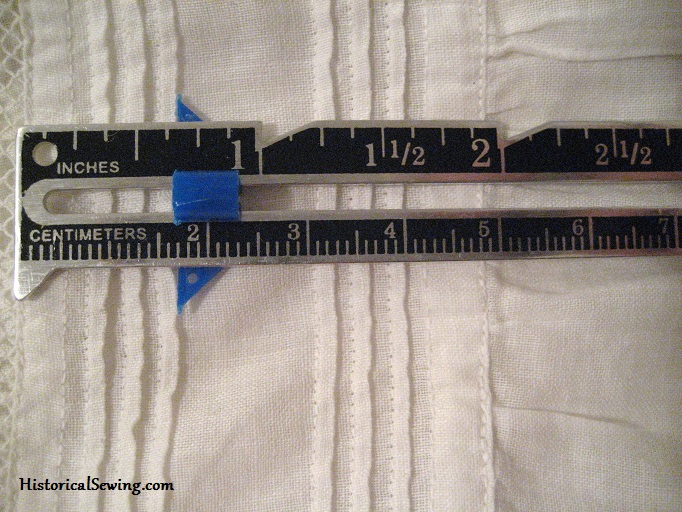
Fabrics
One secret is to use the right fabrics. Thin ones. Sheer. And cotton or linen. Pintucks just don’t look right in silk or wool; although, you will see some tucks in wool but they are larger size and not the delicate tiny tucks.
Fabric options:
Batiste – domestic or imported Swiss
Voile – although this may stretch as you sew the tucks; starching first will help
Lawn – a slightly stiff cotton but beautiful for pintucks
Organdy – get the soft finish style
Cambric – period fabric from cotton & linen or all linen; slightly stiff hand; hard to find nowadays
Needle/Thread/Notions:
Use a new machine needle in size 60/8 or 70/10.
For thread, a basic all-cotton will be fine. Also a standard cotton wrapped polyester core thread works too. There’s no reason to spend the money on silk thread unless you really want to. The originals were done in cotton.
Also needed to make pin tucks: a seam gauge and steam iron.
How-To Tutorial for Pintucks
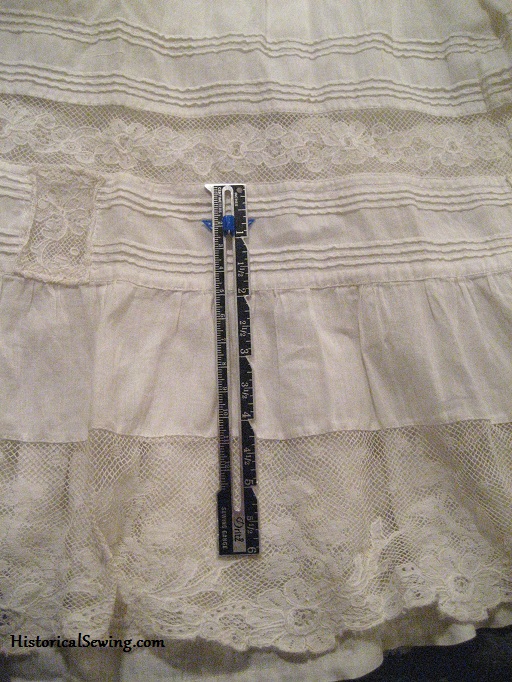
For this tutorial I decided to copy the pintucks as were made on an original Edwardian petticoat. The original is in cotton lawn and is very soft. (I hope to make a pattern from this petticoat as it’s too gorgeous to hide.)
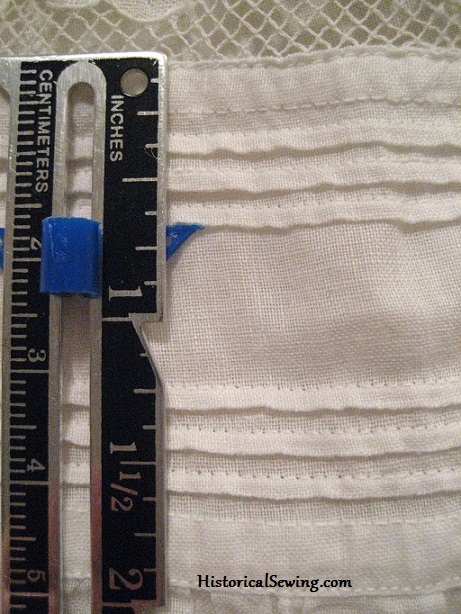
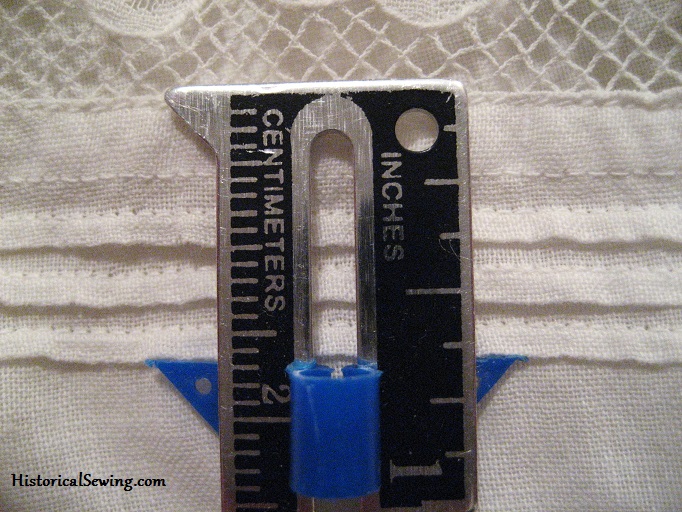
The original tucks are a tiny 1/16″ and grouped in two sets of threes. So incredibly small!!
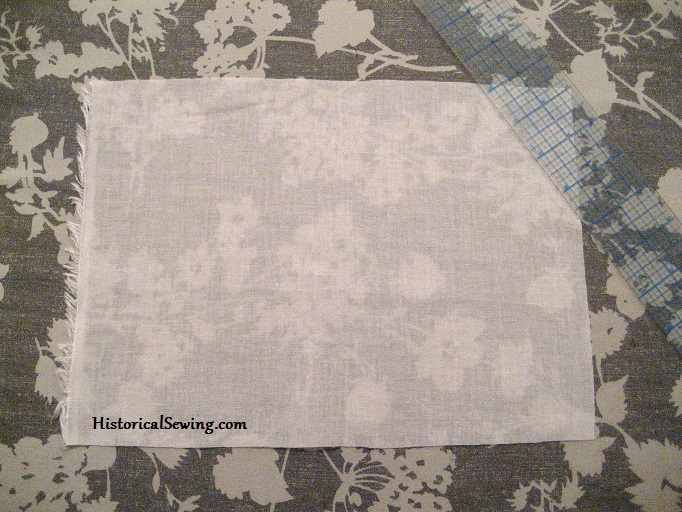
To start the tutorial I used a piece of cotton voile which is unstarched and fairly light. (You can see the same fabric made up as Edwardian undergarments in this post.)
The thing to remember about pintucks is that it is SO MUCH EASIER to sew the tucks into a panel of fabric THEN cut your garment piece from it. If you try to make allowance for the tucks and cut the garment panels as such, with all the variables in sewing these tiny elements you could end up with a larger or smaller piece than expected. It really just doesn’t work this way. Save yourself trouble and pintuck a strip of fabric first then cut out your garment piece.
Also – you want to make pintucks that follow the cross-grain of the fabric. You can follow the grain too (vertical tucks), but keep them straight as such. Don’t try to make pintucks on the bias. Yep… too much hair-pulling for no reason. Pintucks provide body & support and don’t need the stretch of bias.
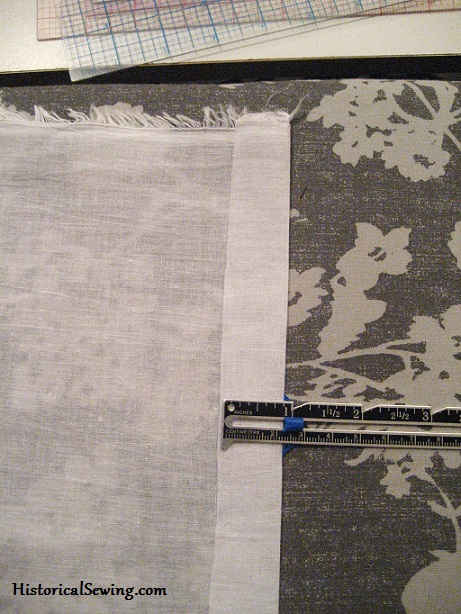
I started by simply pressing up 1″ on the long straight edge of my sample piece. This allows for seam allowance for hemming or sewing to another piece of the garment. This amount can vary.
Then you sew! This is where you decide how wide your pintucks will be. In this sample I’m copying the original petticoat and sewing a tiny 1/16″ from the folded edge.
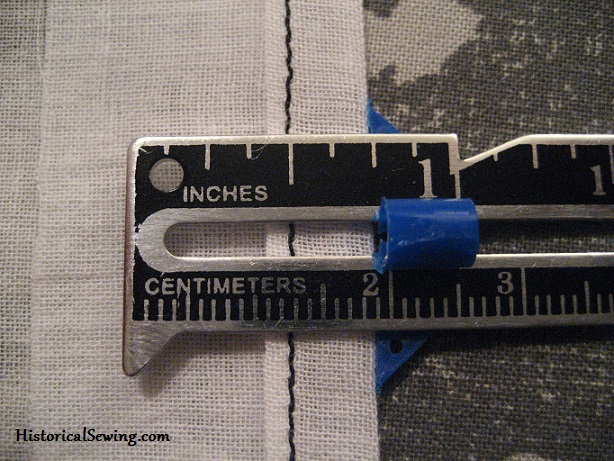
Press the seam you just sewed flat then press the tuck down. Fold the fabric back again and press. I measured 1/4″ away from the first pintuck stitch line to the next tuck fold. Sew again at 1/16″ from the fold and press flat then down.
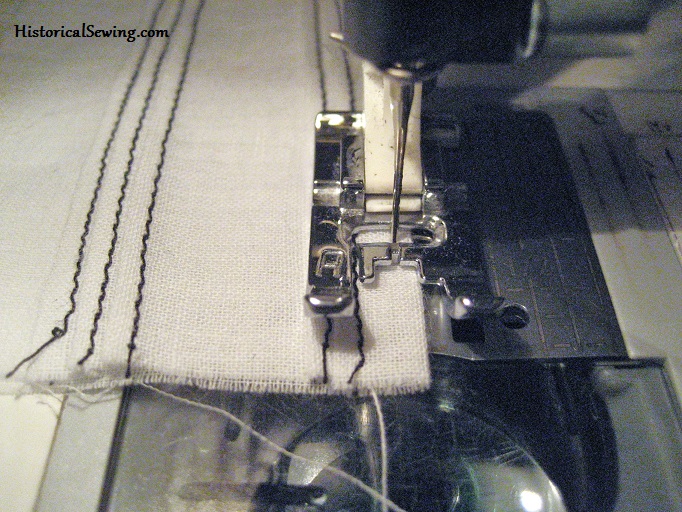
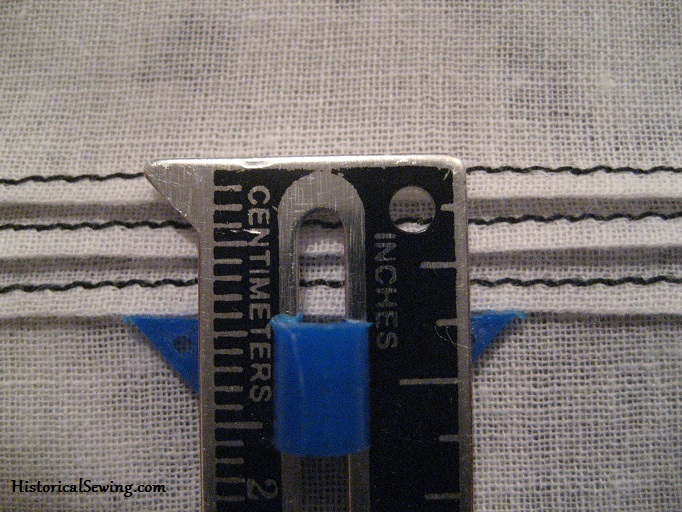
I did three in a row in this manner – all sewed at 1/16″ from the folded edges and pressed facing down.
Looking back at the original petticoat, the sets of tucks were not quite a full 1 inch apart. So I then measured 1 inch from my last finished tuck and pressed a new fold. Then again, sewed next to the fold 1/16″ away.
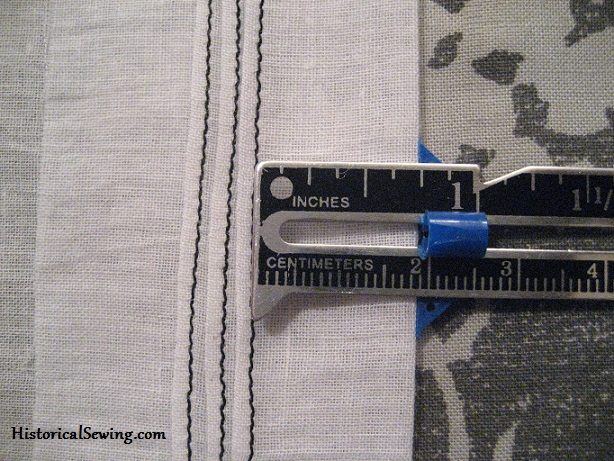
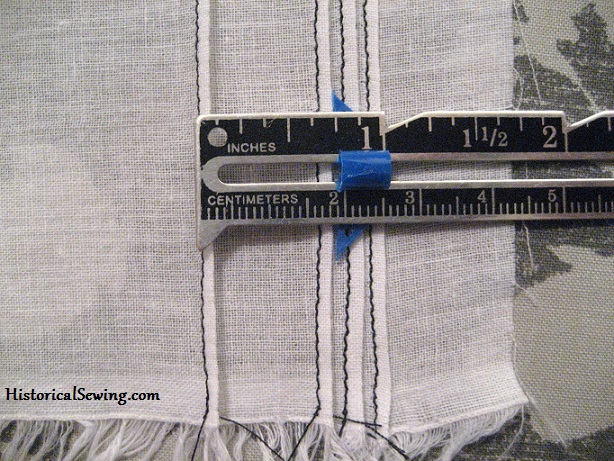
It’s important to press each tuck stitching flat first then press the tuck down into place. The first “flat” press helps set the thread into the fabric fibers. It creates a more blended stitching.
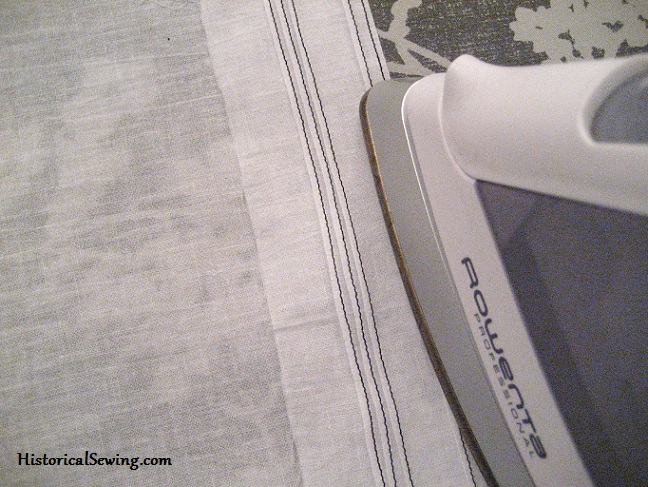
And here’s my finished sample of two sets of 1/16″ pintucks!
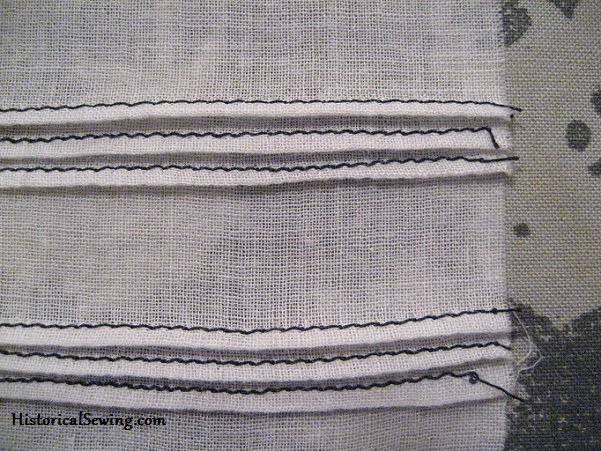
I’ll admit that even in this small (about 8″ wide) sample the voile fabric was quite a challenge to keep all my stitching rows straight and even. Voile can pull out of shape very easily. Therefore, be sure to take your time, go slow, and pull the fabric taut both behind and in front of the presser foot. A good starch of your fabric panel to be tucked will help immensely in sewing pintucks.
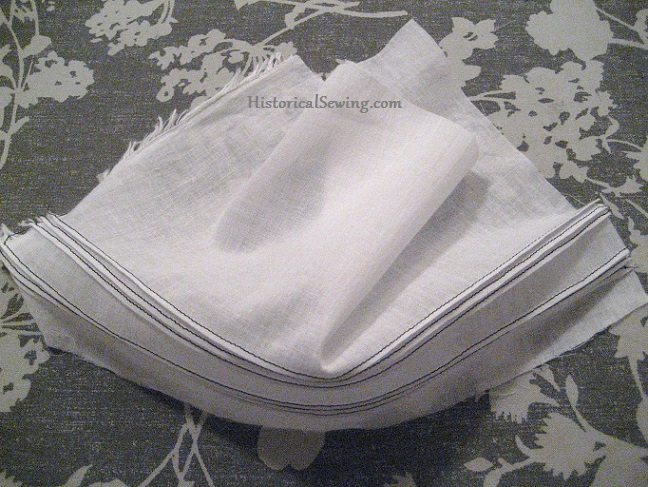
You can see here how even two small sets of pintucks can create quite a bit of body in the fabric. The voile is really drape-y but the pintucks give it support. You can see how this would be perfect for panels on petticoats to offer a good solid foundation at the hem to support the outer skirt.
Use pintucks for insertions on shirtwaist (bodice) yokes and in chemisettes, too, for a bit of delicate Victorian & Edwardian dressmaking.
Have you made pintucks before? Are you surprised they are relatively easier than you thought? What will you use them on next?

I have been asked to make a dress for a family member that “I think” requires pin tucks. Do you have an email address I can send you my picture and get your opinion on how to accomplish the look?
HI Michelle. You can use the Contact page here on the blog site or sewing at historicalsewing (dot)com.
A wonderful surprise finding your site. I have a vintage dress which I purchased many years ago and a local “resale” shop. It was incredibly cheap but the jacket is in tatters. I’ve tried to figure out what genius created this marvelous flapper style and recently noticed a sewn in tag. It is a designer dress of unknown date. Created entirely with pintucks-tag. It is a silk organdy by Evelyn Byrne. I cannot imagine anyone with in a sane capacity actually hand sewing thousands of pintucks. How wonderful of you to be sharing this magnificent work to any and all.
Welcome to our Joyful Community, Mary Lou!
Thank you so much for this tutorial. I followed your directions for my 1900’s drawers, a first row of 3 pins and a second row (1″ away) of 5 pins. I think with my lace bottoms it will be perfect. Thanks again!
Whoot! So glad this helped you. 🙂
Sorry, I can’t follow these instructions.
It looks like, ‘take a piece of cloth and hem it one inch deep stitching 1/16 inch away from the edge of the fabric. Then sew tucks. Here’s a picture of three rows of tucks’
.
There’s a picture with the caption, ‘Pressing the 2nd fold for a new tuck.’ Are you pressing a fold with that ruler? It doesn’t look like any fold is being pressed there. If you can ‘press a fold’ with a ruler, this beginner needs more information and better pictures.
The picture captioned, ‘Stitching on the fold to create the pintuck’ just looks like rows of black thread on white cloth; I can’t see any ‘tucked’ material there, nor can I see any ‘fold.’ It looks like the line under the foot of the machine is quite far from any fold..
I’ve read and looked at the pictures a few times – still no clue how you go from black lines on a flat piece of folded cloth (a hem) to pin tucks.
The people who can follow these instructions must already know what you are talking about. For my part, I cannot see any step where you fold the tiny tucks all along that length of fabric and somehow get them to stay in place when you fold them down.
Yes, they are a bit like making a tiny hem… but it’s really not a hem. You press the fabric back, wrong sides together, then stitch xx amount away from that pressed edge. This IS the tuck. How much width you stitch away from the pressed edge is the final width of the tuck. You then press the tuck to one side. I show the seam gauge in the photos to indicate how small the pin tucks are. You don’t need to measure from the fold to where you will stitch… most times you can use the face plate with seam allowance markings to sew the width you want for the tuck. You DO, however, need to measure where to press back the fabric to create the fold so the tuck is sewn evenly across your fabric.
Pin tucks are very small – meaning, you keep your stitching quite close to the pressed edge. You’ll find various sources as to what widths are considered “pin tucks” but I think anything less than 1/4″ stitch from the pressed fold is a pin tuck. Larger widths can simply be called tucks. Perhaps your definition of pin tucks is different than mine – quite ok. So sorry the tutorial seems confusing to you. I’d suggest you get out a scrap of fabric and try to work through each step to understand more of what’s going on. Taking action with fabric and stitching can help get the mind to “click” on how it actually works. Good luck! 🙂
That petticoat is so beautiful it makes me want to cry. Where did you get it? I dream of floating about a spring garden wearing it under my long skirt… Oh, I adore pintucks.
I’m not much of a historical sewer or reenactor, but I am very interested in costume history and the history of dressmaking and tailoring as crafts. I’m also a modern sewer who loves some of the shapes and styles of historical fashion – particularly the fact that outfits from the 19th century tend to fit at the waist, which suits me far better than the looser tops that have been in fashion for the past fifteen years or so…!
I’ve been dreaming for some time of a pintuck blouse, but I wasn’t feeling fantastically confident about executing the tucks, and this tutorial will definitely help, so thank you! I’ve recently discovered your site and am devouring its contents.
On the subject of tucks in heavier fabrics such as wool, is it possible to make horizontal tucks in a flared skirt? The curve would seem to make it very difficult!
Thanks again, and best with all your current projects.
Hi Anna,
Welcome to our Joyful Community! 🙂
I got the antique petticoat at an antique mall. Keep your eye out for antique garments wherever you go!
For flared skirts – such as those in the Edwardian era – I’ve seen the tucks get sewn in horizontally to the floor and also parallel to the skirt hem or other flared ruffle seam. Both work. When on a curve you’ve got a little bit of bias in the fabric to work with which can make it easy or challenging. Play with the tuck width to see what works better on the bias angle you have in the skirt.
Hello, and thanks for both the welcome and the advice!
Good to know it is not impossible to sew such tucks. I have indeed seen pictures of such skirts from the Edwardian era, but wasn’t sure how best to execute them. Thanks for the tips, and happy sewing!
I’ll be back. 🙂
For light weight fabric I was taught be my teacher to place a piece of tear away behind. It helps stabilize the fabric and make keeping that tiny width correct. I love pin tucks. I do have a tucking foot that came with my 1910 singer treadle that I use for all my sewing on pin tucks. I love my treadles, all 6 of them.
I have some sheer (almost white) grey linen. I am placing pin tucks from the (to be bound) neck , over the apex of the breast (the double layers of tuck will make more opaque on a peasant top. I plan on a long tunic (I live in phoenix and casting my own shade is a boon on hot days) So I want volume and I want shape, too. I also am placing them center back from neckline to waist line – so there is some shape to the back (I am flat in the hind) – the tucks released should make a bustle- like lower center back. I have gotten as far as pulling the vertical threads on either side of the center (space near the center and at about 1/3 and 2/3 of the width of the front) – my hope is that when I fold on the gap made by the pulled threads I will have a ladder of open threads to spruce up the blouse while still keeping true to the simplicity of a peasant blouse. On the (raglan) sleeves I plan to place triple pin tuck to frame a triple a pulled thread runner (spaced out to about a three inch design area) on a three quarter slightly gathered cuff sleeve. Your tutorial really helped me recall all the important details before I begin the actual stitching Thank you for such a nice way to cover this topic. You boosted my confidence and now I will sew..
Sounds like a wonderful plan Sharon. Good luck with the sewing! 🙂
im kinda a sewing snob and to get me to compliment your tutorial is, to me, pretty big. Excellent. Motivating. Thorough. Clear, complete, and most importantly to me, concise, to the point.
Thanks Miss tish! So glad you found it satisfactory. 🙂
Greetings Madame
I will my keep first comment short by thanking you for your generosity in sharing your knowledge and experience. I sew for myself and my wife. Tailoring pattern books for men and Women from the Internet Archive are an exciting historical window and a practical guide of instruction;but there are several technics that only experienced hands can demonstrate-with devotion and appreciation-your newest student
-Have you been to this page yet?–Farewell until my next comment;thank You
Welcome OldSchool Gent!
I have done pintucks before, but not quite such teeny ones! They are beautiful. I have never heard of a double needle and special foot. I’ve always just ironed and sewed as you taught here. Works wonderfully every time! My favorite project using tucks was an 1860’s under-petticoat. 🙂 I’ve since used them on blouses, baby dresses, and more. And I’ll continue to use them in the future. Loved the photo of the original petticoat.
i’VE ALWAYS BEEN AFRAID OF PINTUCKS.nOW i’M GONNA GIVE THEM A GO! tHANK YOU SO MUCH
Thanks for sharing such a great tutorial! I have tried in the past and have failed miserably lol Will give your method a go though, you make it look super easy. Many Thanks, Sasha 🙂
This is going to make growth tucks soooo much easier and with a lot less pencil and chalk marks! Thank you so much.
The first time I tried to sew pintucks, I was lazy, and didn’t measure them exactly; I actually thought I could just eyeball them. *BIG* mistake! You can imagine the result, I’m sure. Yet another example of how skipping steps and being lazy ends up costing you more work one way or another.!
I’ve only ever made pintucks in this fashion. I’ve never tried using a double needle. This tutorial works very well and like you said, Iron! Ironing as you go may seem tedius but will make everything beautiful. What you said about cutting out the pattern pieces after the pintucks are sewn reminds me of the examples we have of embroidered clothing pieces. Queen Elizabeth’s Wardrobe Unlock’d has photos of stockings and sleeves that were embroidered but never cut out. You just never know what the fabric will do.